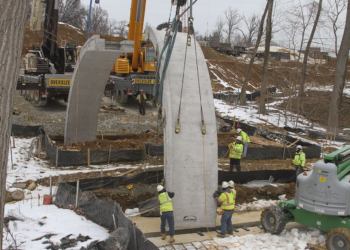This article is taken from the April 2025 issue of The Critic. To get the full magazine why not subscribe? Right now we’re offering five issues for just £10.
Everybody knows the term “grooming gangs” is a euphemistic cliché. It speaks to the enormity of the moral squalor that we haven’t even got decent shorthand to describe: the culture of depraved, systematic abuse by men overwhelmingly of Pakistani origin against local girls in town after town which was either ignored or excused by the British authorities, media and society for decades. Somehow, all the alternative terms fall short in one way or another; either too leaden or too narrow.
For all that campaigners, journalists and a handful of politicians have tried to blow through the tissue of taboo that forbade pattern recognition and discussion of the undeniable racial angle of the affair, we still struggle to get to grips with what actually caused it. Partially, this is because there are many observers who insist that their own preferred explanations must sit atop the hierarchy of reasons why — from Islam to the inherent violence of male sexuality.
The structure of the societies the offenders came from has been transplanted to Britain
There is merit to many of their arguments, at least partially because the conclusions are simply too painful and too incompatible with the basic assumptions of modern British society for many to tolerate, even among dissenters on the political Right.
I suggest the answer lies in the structure of the societies that the offenders originated from, and which has been transplanted into parts of the Pakistani diaspora in England. Islam has played some part in the shaping of that structure, but my feeling is that the religion’s role in these crimes goes little further than that. The root of the problem is older and deeper.
Laying blame on cultural factors rather than squarely at individuals is not to excuse perpetrators who rightly remain morally and legally responsible for their crimes. But to understand how so many people within a community have been complicit, either actively or passively, we need to understand the ideas of morality that exist in that community, and why their ideas of who is entitled to justice and protection apparently differ so profoundly from that of the British mainstream.
These ideas of justice — both theirs and our own — are ones that have developed over countless generations and centuries, and we need to look at how and why they came to deviate so sharply, if we are interested in the possibility of reconciling them.
✖
For most of human history, social rules designed to contain the impulsive coding of adult males to perpetuate their own genetic legacy by any means available and reassure them that they are the father to their own children have involved strict conventions that enforce female monogamy and ensure female virginity prior to marriage.
But these rules were only applicable to relationships within that group or society. Encounters between different groups of people in pre-agricultural history were often violent — and following the emergence of states, sexual violence and the abduction of women became a routine part of warfare.
Over time, as states grew more sophisticated, their goals in the regulation of sexual behaviour and morality were adapted for new political and economic purposes. The emergence of large, tightly knit clans presented a challenge to the authority of the state and its rulers, and those that had the authority to do so — most notably the Roman Empire — clamped down on consanguineous marriage in order to break the clans up.
This practice was taken up with gusto by the Christian church, shaping many of our Western social conventions and taboos about cousin marriage. Various states also saw a surfeit of poor, unmarried and childless men as a threat to order and clamped down on polygamy — among the general population at least.
In those societies that emerged from Roman rule and remained Christian, there was finally an absence of overbearing kinship structures. Depending on the economic model adopted, there emerged in various European societies, and especially in England, an increasingly individual conception of morality and of justice. Rules and social conventions around marriage and sex remained robust, however the individual, including individual women, had vastly more power over how and with whom they married and had children. Violations against individuals were punished as such, rather than for the insult they did to the rights of the father, the husband or the extended family.
Finally, the ideals that sprang from the European Enlightenment saw this individualism proclaimed in the form of universal rights. For the heirs of the Enlightenment and those who followed Western ways of thinking, the distinction between the in-group and out-group was broken, at least in terms of the application of morality, and in terms of the standing of the individual to seek recourse to justice. This conception of morality applied equally to any individual, and did not depend on his or her position within a family, tribe or a nation, but was instead inherent to their humanity.

So what of the community at the centre of the grooming rape scandals in English towns? I do not claim that communities originating from the Mirpur Valley of Kashmir were solely responsible for this kind of criminal activity. But they do seem to have played a critical part in it across dozens of different towns, and there are substantial concentrations of Mirpuris in the vicinity of the majority of the towns where this pattern of abuse has been confirmed.
The Mirpuris — like most people from Pakistani Kashmir — are not ethnic Kashmiris; they are descended from people who moved to Kashmir from the Indus Valley Plain centuries ago who speak a dialect of a language related to Punjabi.
The easiest way to describe the Mirpuris is that they are Muslim Punjabis who were geographically isolated in remote, mountainous areas for many centuries, at the peripheries of a succession of empires and states to which they owed varying degrees of loyalty, including the Delhi Sultanate, the Kashmir Sultanate, the Mughals, a period of time under Afghan and Sikh domination, then British India and independent Pakistan.
The concept of “consent” is simply not relevant in such a structure
To the extent that the Mirpuris were ever loyal to these powers (and they generally were to the Muslim rulers and to the British), they retained a strong degree of local autonomy in terms of how they ran their own affairs. They were functionally independent almost by default due to the geography they lived in. And geography was critical to their social development; it was remote yet in proximity to hostile populations.
In consequence, there was never an overbearing state enforcing a ban on consanguineous marriage or polygamy. In any case, it is very difficult for Muslim rulers to forbid those practices, as they were clearly acceptable to the Prophet. The people had brought with them to Kashmir the tightly-knit kinship networks of the Punjabi tradition; the biraderi model of mutually reinforced bonds of social obligation.
But remote valleys have always been natural incubators of clannishness, as people ensure protection through a chain of bonds between kin. The position of the Mirpur valley on the periphery of a succession of empires reinforced this process and created an exceptionally tight-knit kinship network — possibly only the Pashtuns in Afghanistan and the Khyber have a more rigid structure.
This created an inward-looking, clan-based model that prioritises group self-preservation and has an especially strong in-group/out-group differentiation. There is a very limited conception of loyalty to central government or to its laws; rules are enforced internally by clan elders, whose priority is dispute resolution rather than justice on an individual basis. Women outside of the clan structure (which encompasses the whole ethnic group) are not of any interest to this resolution mechanism and are not covered by any of the rigid internal rules that prohibit unlicensed intermingling between unrelated Mirpuris of the opposite sex.
As was ever the case with traditional, communal cultures, it is context rather than consent which determines whether a sexual act is legitimate. The concept of “consent” is simply not relevant in such a structure. Within the community, rape is a dishonour to the vicitim’s family, and redress would be sought between those two families.
The result would likely be unpleasant for both the subject and the object of the offence. This is a culture in which the idea you could rape your own wife would be considered bizarre. As far as Mirpuri morality was concerned, consent in terms of sexual encounters with women unrelated to the community was irrelevant, because the context was outside its jurisdiction.
✖
So what happens when you transplant this kind of culture into a rapidly de-industrialising town in the North or the Midlands of England in the late twentieth century? The most important thing to note is that the biraderi clan structures did not become any weaker once Pakistanis arrived in Britain. Firstly, the clans played a critical role in facilitating chain migration into the UK, and then once people arrived, they played a big role in people’s lives as they settled.
Whereas individuals back in Pakistan may have relied on extended family networks for access to electricity or a telephone, in the UK, families were critical in arranging visa sponsorship, finding employment and accommodation, providing legal assistance and generally navigating life in an unfamiliar land. So rather than a loosening of social bonds as they moved into a more individualistic society, the experience of diaspora if anything reinforced the biraderi structure among Muslim Punjabis in Britain.
The England they were arriving into was a society undergoing rapid change. The revolution in personal morality had, by the mid 1970s, trickled from bohemian metropolitans down to ordinary provincial people. The taboos against premarital sex and divorce had vanished within less than a generation, and people stopped even going through the motions of organised Christianity. And then, basic manufacturing industries, especially the textile industries that the Pakistanis were initially brought in to staff, began closing down or leaving the country.
Despite the gloomy way that deindustrialisation is generally reported in the period between the 1960s and the 1990s, for many people it was a time of opportunity and social dynamism. There was an exodus of people from the world of nineteenth-century towns and cities for new economic opportunities in more advanced industries higher up the value chain. These were less concentrated, as they could rely on smaller, car-owning workforces.
Millions decamped for leafier locations, leaving behind those who lacked the wherewithal or motivation to move; the old, the unemployed and broke, the single mother with small children. Among such people, the mixture of unemployment and more relaxed social rules accelerated the process of family breakdown.
White working-class extended families, made up of multiple nuclear families who all knew each other because they lived on the same few rows of houses and went to the same school or church, were broken up. With them vanished the social safety mechanisms people had adapted to replicate the village culture their forebears had left a century or more earlier.

The process of chain migration by Pakistanis into de-industrialising towns and cities accelerated as the exodus of whites began in earnest. As new immigrants followed members of their extended families into particular neighbourhoods, they came to assume dominant positions in hyper-local housing markets. A process of spontaneous self-segregation kicked in as the remaining whites moved out of those areas in which incomers had become pluralities or majorities.
Another advantage that the tight-knit biraderi structure gave to the Pakistani community was the pooling of financial resources and access to credit for extended family, which enabled them to establish independent businesses; fabric shops, convenience shops, restaurants, takeaways and taxi firms. By contrast, what was left of the white, British community by the 1990s came to appear sad and dysfunctional. There were no informal credit markets, and they lacked the borrowing capacity to start small businesses; so the absence of basic industries made unemployment endemic.
Family breakdown and the absence of extended family structures meant that a lot of vulnerable individuals, including children, were left dependent on whatever state support was available and, failing that, on their own wits. Substance misuse and chronic low educational attainment begat generational crises. The authorities, in the form of schools, police and social workers, developed an impression of the whites as the problem community. Whatever problems may have existed within Pakistani households, it was always kept behind closed doors.
Among Pakistani communities such as the Mirpuris, the impression was even stronger that their white neighbours were dissolute and amoral. Sexually, as far as the Pakistanis could see, the whites were allowed to do whatever they wanted with whomever they wanted. They were without honour, and thus incapable of being dishonoured.
Local authorities across northern England were paranoid about the rise of the British National Party
And even if it were possible to dishonour a white girl, who was there among her kin who had standing to take it up with the elders? Her mother? She had no clan; she had no people. And furthermore, she wasn’t even Muslim.
Provincial British police forces and social workers were left to try to figure this out by themselves since there was effectively zero cultural or anthropological interest in the Asian communities that had settled in England either from academia or from government. This was the era of the Macpherson Report, and memories of intimidation by the National Front were recent, which there was a sense that the police hadn’t done enough to stop. After 2001, serious worries about radicalisation and terrorism started to dominate the way the security state approached the Pakistani Muslim community, whom the police were keen not to alienate any further.
✖
There has been a tendency to portray official indifference, especially by social workers, toward the victims and their families as being evidence of middle-class snobbery toward their imagined social inferiors. No doubt there is some truth to this. But this misses the extent to which many police officers, social workers and teachers were drawn not too distantly from the same communities as the victims.
These were people who had moved up a few rungs on the social ladder by virtue of their professional careers. If they did have advanced academic qualifications, they were not likely to have been from prestigious institutions. These were people who learned politically correct buzzwords from flipcharts on away-days in venues near motorways, rather than by osmosis from hanging around fashionable peers on campus.
Theirs was an insecure grasp on social status and their jobs were all too easily jeopardised by venturing a controversial hypothesis about what might be driving a new and alarming pattern of criminality.
This instilled an almost pathological naivety in the way the authorities approached the issue at the local level, which precluded the kind of pattern recognition that the British state is only now being forced to recognise. The addition into the mixture of local government (and even more controversially, into the police) of members of the Pakistani community, is a far more controversial issue that demands proper research and inquiry.
However, even without that element, we do know that local authorities and elected councillors from all of the main parties across northern England were paranoid about the rise of the British National Party throughout this period. They would do anything to avoid highlighting or lending credibility to the BNP’s narratives.
I cannot propose solutions here to the issues that I’ve raised about the social structures of Pakistani Muslim communities. It strikes me that any intervention that was likely to be effective would require a degree of intrusiveness that the British state has never previously considered. Surely, any social policy that was designed to replicate the processes of centuries of cultural and moral conventions in a few generations would be completely incompatible with any notion of English liberalism?
But how else to ensure compatibility between those communities and the British mainstream, given that they have now lived among us for multiple generations? In the words of the apocryphal farmer suggesting directions to a lost traveller:
I wouldn’t start from here.







